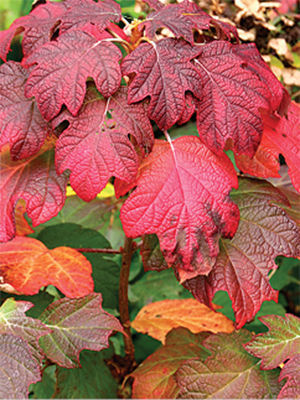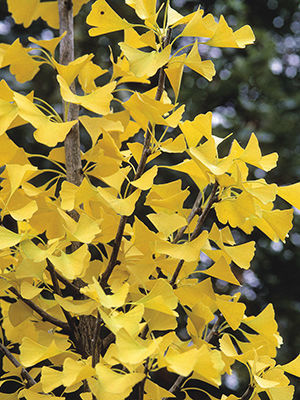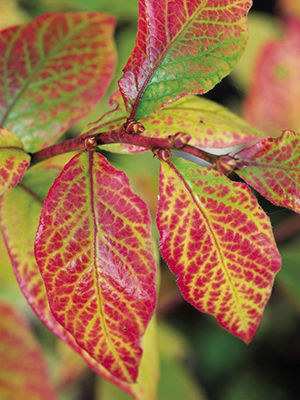1. Table Grapes

Name: Vitis labrusca cvs.
USDA hardiness zones: 5 to 8
Size: 5 to 25 feet tall and 5 to 15 feet wide
Conditions: Full sun; good air circulation and fertile, slightly acidic, well-drained soil
With their vining habit and fabulous foliage, table grapes really shine this time of year. Many native and hybrid varieties produce fruit from late summer to fall with colorful, flavorful grapes unlike anything you’ll find in the supermarket. And the boldly textured leaves take on fall with multitonal foliage in varying shades of yellow, orange, red, and purple. Seedless grapes are self-pollinating. The vines grow quickly up an arbor or trellis and also provide shade when grown up a gazebo or pergola. Water first-year plants weekly during dry periods; once established, the plants are somewhat drought tolerant.
2. Oakleaf Hydrangea

Name: Hydrangea quercifolia and cvs.
Zones: 5 to 9
Size: 3 to 8 feet tall and 4 to 8 feet wide
Conditions: Full sun to light shade; moist, humus-rich, acidic to neutral, well-drained soil
This deciduous shrub is a hydrangea with year-round interest. Elongated clusters of late-spring to midsummer flowers bloom from white to pinkish purple as they age. Summer’s show features deeply lobed, oak-shaped leaves, which turn orange to crimson in fall. And winter reveals shaggy, exfoliating, reddish brown bark. For the best bloom and fall color, grow this hydrangea in an area with full morning sun and light afternoon shade, and rake in compost or rotted manure into the soil each spring. Oakleaf hydrangea is less tolerant of wet feet than other hydrangeas. Growing plants in a raised mound or soil rich in organic matter will improve drainage.
3. Maidenhair Tree

Name: Ginkgo biloba and cvs.
Zones: 5 to 9
Size: 35 to 50 feet tall and 15 to 35 feet wide, depending on the cultivar
Conditions: Full sun; deep, fertile, well-drained soil
Easy to grow and extremely long-lived, this prehistoric deciduous tree is tolerant of a wide range of conditions, including soil types, soil pH, heat, salt, air pollution, diseases, and pests. The tree grows slowly, and seedlings can take more than 20 years to flower. Male trees that have been grafted or grown from cuttings of male plants avoid the foul-smelling fruit produced by females. Named varieties ideal for our area include ‘Autumn Gold’, ‘Saratoga’, and ‘Princeton Sentry’ (pictured). The leathery, fan-shaped leaves of maidenhair tree flutter in the wind, then turn a gorgeous shade of golden yellow, making it a handsome substitute for quaking aspen (Populus tremuloides, Zones 1–8).
4. Highbush Blueberries

Name: Vaccinium corymbosum and cvs.
Zones: 3 to 7
Size: 4 to 6 feet tall and wide
Conditions: Full sun to partial shade; moist, acidic, well-drained soil
Long-lived deciduous highbush blueberry bushes are beautiful in the landscape, with attractive flowers in spring; colorful blue berries in summer; and foliage in shades of red, orange, and yellow in autumn. Set plants 4 to 5 feet apart, or space them 3 feet apart for an informal hedge. This attractive edible shrub can be grown in a kitchen garden, on the edges of a woodland garden, in combination with other acid-loving plants in borders, or as structural interest in perennial beds.
Kris Wetherbee is a former organic-market grower who maintains multiple orchards on her 38-acre farm in western Oregon.
Photos: #1 and #4, Richard Bloom; #2 and #3, Bill Johnson.
Fine Gardening Recommended Products

Planting in a Post-Wild World: Designing Plant Communities for Resilient Landscapes
Fine Gardening receives a commission for items purchased through links on this site, including Amazon Associates and other affiliate advertising programs.

The Crevice Garden: How to make the perfect home for plants from rocky places
Fine Gardening receives a commission for items purchased through links on this site, including Amazon Associates and other affiliate advertising programs.

Corona® Multi-Purpose Metal Mini Garden Shovel
Fine Gardening receives a commission for items purchased through links on this site, including Amazon Associates and other affiliate advertising programs.


















Comments
Log in or create an account to post a comment.
Sign up Log in